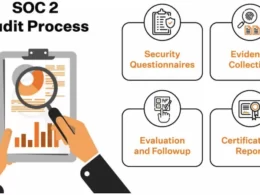In a world where technological vulnerabilities are rapidly surfacing, a SAP data leak represents a significant and often overlooked risk to enterprise data integrity. Similar to the notorious ransomware attack, SAP data leaks can compromise operations, jeopardize sensitive data, and erode customer trust within moments.
The root of the problem often lies in the lack of proper data visibility and control and underestimating the importance of strong Data Loss Prevention (DLP) mechanisms. Given the critical nature of the data housed within SAP systems, it’s high time organizations shift their focus towards enhancing data governance frameworks and implementing effective data security solutions to prevent such devastating breaches.
Inside the SAP Data Leak
Today’s landscape is dominated by technological advancement and digitalization, leading to a modern interpretation of an old saying: “Loose data can sink corporations.” The peril of SAP data leaks perfectly embodies this modern-day predicament. These leaks occur when valuable and confidential data, nestled within the software systems of SAP – a renowned vendor of enterprise resource planning – gets unveiled, courtesy of system glitches or human oversights.
Let’s look into a bizarre incident that left the tech community wide-eyed and astonished. In November 2022, four SSD disks disappeared from what was believed to be a secure data center in Walldorf, Germany. One of them rather surprisingly popped up on eBay. The situation could be compared to a high-stakes, IT version of hide and seek but with much greater implications. These disks were not in cold storage; instead, they were unaccounted for, harboring sensitive data.
Here’s the catch – these SSD disks had been relocated from their original secure sanctuary to a less secure edifice within the SAP HQ compound. From there, they were unlawfully taken. The mystery started to unfold when a vigilant SAP employee chanced upon one of the lost disks on eBay and decided to buy it.
This event underscores the inherent risks and susceptibilities tied to data storage and security. Despite the data center being labeled as a “secure area,” the SSD disks were anything but secure. This incident served as a wake-up call to SAP and other corporations about the gravity of data security. In this digitized age, data leaks are far from just being an embarrassment – they can inflict severe financial and reputation damage. So, while the tale of the roving SSD disks might have been amusing, it’s a vivid reminder that complacency can have no place in data security.
Preventing Data Misuse and Leaks
The case of the missing SSD disks in Germany is a stark reminder of the pressing need for greater data visibility and control within organizations. In these digital times, data is perpetually moving, making it difficult to track and secure. It’s constantly being created, accessed, shared, and stored in various locations, including on-premises servers, mobile devices, and cloud platforms.
Improving data visibility and control is not just about compliance or avoiding fines but also about safeguarding the organization’s reputation, maintaining customer trust, and ensuring operational continuity. By gaining a comprehensive view of their data’s lifecycle and implementing stringent control measures, organizations can prevent data breaches and mitigate the risks associated with data mishandling.
Data security solutions like DLP play a crucial role in tracking and safeguarding sensitive data within an organization. DLP solutions can identify, classify, and tag sensitive data, keeping a keen eye on the data’s journey from inception to storage. They also monitor activities and events that happen around this data, ensuring that it doesn’t fall into the wrong hands or get misplaced.
Here are some features of how DLP aids in data security:
- Sensitive Data Identification: DLP solutions can identify and classify sensitive data in an organization, providing a clear picture of where this information resides.
- Activity Monitoring: DLP tools monitor and control endpoint activities, filter data streams, and protect data in the cloud to prevent data loss.
- Policy Enforcement: DLP software identifies violations of policies and enforces remediation measures, helping to prevent data breaches.
- Reporting Capabilities: DLP solutions also come with reporting capabilities, enabling organizations to gain insights into potential security threats and the overall health of their data security.
- Encryption and Insider Threat Mitigation: Experts recommend using DLP solutions with encryption to enhance data security. DLP also helps mitigate insider threats, which are often overlooked but can lead to significant data breaches.
A well-constructed data governance framework can also aid in preventing unwanted data leaks by providing a structured approach to manage, secure, and utilize data while ensuring that data is handled correctly throughout its lifecycle. Data governance involves implementing policies, procedures, and standards that dictate how this data is collected, stored, shared, and used within an organization. This framework helps to prevent data mishandling and breaches by promoting transparency and accountability.
Here are some key elements of a successful data governance framework:
- Data Stewardship: Assigning roles and responsibilities for data management can help ensure accountability.
- Data Quality Management: This ensures the accuracy and completeness of data, improving decision-making and reducing the risk of errors.
- Data Privacy and Compliance: Adhering to data protection regulations can help prevent unauthorized access and data breaches.
- Data Architecture Management: This involves managing the design, description, and structure of data in an organization, promoting consistency and reducing errors.
- Data Lifecycle Management: This involves managing data flow from creation to deletion, ensuring it is appropriately protected and disposed of.
- Clear Data Governance Policies and Processes: Establishing clear, standardized policies and processes on data governance amongst different stakeholders and teams ensures consistency within the organization.
In conclusion, the SAP data leak incident serves as a clear reminder of DLP’s crucial role in today’s digital landscape. Just as with the intricate complexities of API security, understanding and implementing an effective DLP strategy and data governance framework can significantly reduce risk and enhance the overall security posture of an organization.
Therefore, IT professionals and businesses can benefit by fully understanding and implementing these concepts, as they are vital in preventing data misuse and leaks, safeguarding sensitive information, and ultimately, driving a safer and more secure digital world.











